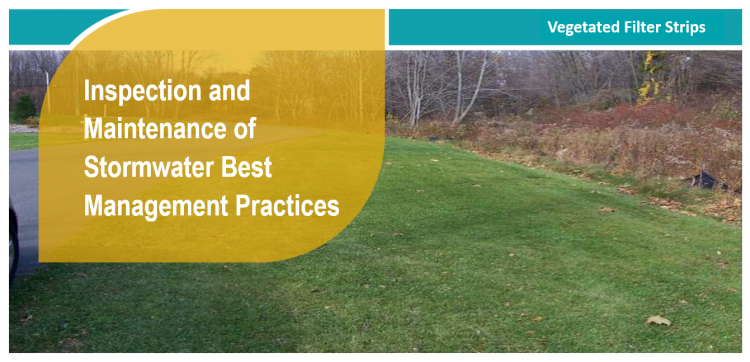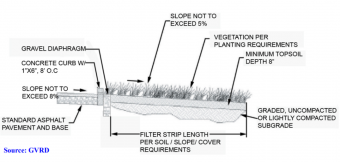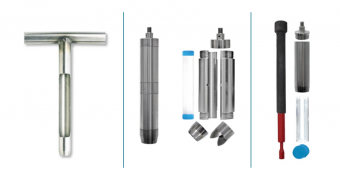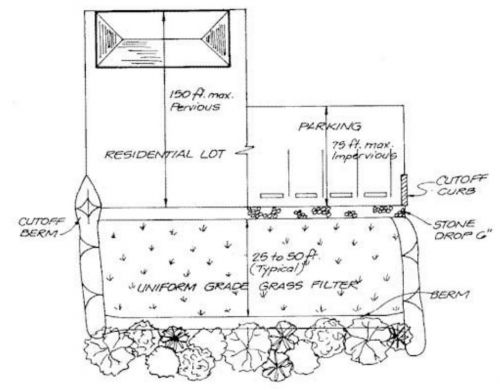Inspection and Maintenance: Vegetated Filter Strips

Overview[edit]
Vegetated filter strips (a.k.a. buffer strips and grassed filter strips) are gently sloping, densely vegetated areas that treat runoff as sheet flow from adjacent impervious areas. They slow runoff velocity and filter out suspended sediment and associated pollutants, and provide some infiltration into underlying soils. Originally used as an agricultural treatment practice, filter strips have evolved into an urban SWM practice. Vegetation may be comprised of a variety of trees, shrubs and native plants to add aesthetic value as well as water quality benefits. With proper design and maintenance, filter strips can provide relatively high pollutant removal benefits. Maintaining sheet flow into the filter strip through the use of a level spreading device (e.g., pea gravel diaphragm) is essential. Using vegetated filter strips as pretreatment practices to other best management practices is highly recommended. They also provide a convenient area for snow storage and treatment, and are particularly valuable due to their capacity for snowmelt infiltration.
Properly functioning vegetated filter strips and soil amendment areas reduce the quantity of pollutants and runoff being discharged to municipal storm sewers and receiving waters (i.e., rivers, lakes and wetlands). In addition to their SWM benefits, they provide aesthetic value as attractive landscaped features.
Key components of Vegetated filter strips to pay close attention to are the:
Trash, debris and sediment builds up at these locations and can prevent water from flowing into or out of the practice.
Associated Practices[edit]
- Grass Swales: A parabolic or trapezoidal-sized bottom, swale that contains grassed sloping sides and a filter media bottom to both convey overland flow and provide water treatment, and are often subject to more frequent maintenance. They generally contain an outlet structure at the lowest point for water to be sent to another LID BMP or the storm system; sometimes referred to as a roadside ditch. Does not contain check dams.
- Swales: Swales are linear landscape features consisting of a drainage channel with gently sloping sides. Underground they may be filled with engineered soil and/or contain a water storage layer of coarse gravel material. Two variations on a basic swale are recommended as low impact development strategies, although using a combination of both designs may increase the benefit.
- Bioswales are sometimes referred to as 'dry swales', 'vegetated swales', or 'water quality swales'. This type of BMP is form of bioretention with a long, linear shape (surface area typically >2:1 length:width) and a slope which conveys water and generally contains various water tolerant vegetation.
Inspection and Testing Framework[edit]

Component |
Indicators |
Construction Inspection |
Assumption Inspection |
Routine Operation Inspection |
Verification Inspection |
|---|---|---|---|---|---|
| Contributing Drainage Area | |||||
| CDA condition | x | x | x | x | |
| Inlet | |||||
| Inlet/Flow Spreader Structural Integrity | x | x | x | ||
| Inlet/Flow Spreader Structural Integrity | x | x | x | x | |
| Perimeter | |||||
| BMP dimensions | x | x | x | ||
| Filter Bed | |||||
| Standing water | x | x | x | ||
| Trash | x | x | |||
| Filter bed surface sinking | x | x | x | ||
| Planting Area | |||||
| Vegetation cover | x | x | x | x | |
| Vegetation condition | x | x | |||
| Vegetation composition | x | x | x |

Component |
Indicators |
Construction Inspection |
Assumption Inspection |
Routine Operation Inspection |
Verification Inspection | |
|---|---|---|---|---|---|---|
| Testing Indicators | ||||||
| Soil characterization testing | x | x | (x) | |||
| Surface infiltration rate testing | x | (x) | ||||
| Note: (x) denotes indicators to be used for Performance Verification inspections only (i.e., not for Maintenance Verification inspections) | ||||||
Construction Inspection Tasks[edit]


Construction inspections take place during several points in the construction sequence, specific to the type of LID BMP, but at a minimum should be done weekly and include the following:
- During site preparation, prior to BMP excavation and grading to ensure the CDA is stabilized or that adequate ESCs or flow diversion devices are in place and confirm that construction materials meet design specifications
- At completion of grading, prior to planting to ensure slopes and elevations are acceptable
- Prior to hand-off points in the construction sequence when the contractor responsible for the work changes (i.e., hand-offs between the storm sewer servicing, paving, building and landscaping contractors
- After every large storm event (e.g., 15 mm rainfall depth or greater) to ensure Erosion Sediment Controls (ESCs) and pretreatment or flow diversion devices are functioning and adequately maintained. View the table below, which describes critical points during the construction sequence when inspections should be performed prior to proceeding further. You can also download and print the table here
Construction Sequence Step & Timing |
Inspection Item |
Observations* |
|---|---|---|
| Site Preparation - after site clearing and grading, prior to BMP grading | Natural heritage system and tree protection areas remain fenced off | |
| ESCs protecting BMP layout area are installed properly | ||
| CDA is stabilized or runoff is diverted around BMP layout area | ||
| BMP layout area has been cleared and is staked/delineated | ||
| Benchmark elevation(s) are established nearby | ||
| Construction materials have been confirmed to meet design specifications | ||
| BMP Grading - prior to landscaping | Excavation location, footprint, depth and slopes are acceptable | |
| Excavated soil is stockpiled outside the CDA | ||
| Landscaping – after final grading, prior to planting | Topsoil depth, degree of compaction and surface elevations at inlets and outlets are acceptable | |
| Area is free of ruts, local depressions | ||
| Planting material meets approved planting plan specifications (plant types and quantities) | ||
| Note: for Observation Column: S = Satisfactory; U = Unsatisfactory; NA = Not Applicable* | ||
Routine Maintenance - Key Components and I&M Tasks[edit]
Generally, routine maintenance will be the same as for any other landscaped area; weeding, pruning, and litter removal. Regular watering may be required during the first two years until vegetation is established. Routine inspection is very important to ensure that dense vegetation cover is maintained and inflowing runoff does not become concentrated within the practice. Vehicles should not be parked or driven on filter strips. For routine mowing of grassed filter strips, the lightest possible mowing equipment should be used to prevent soil compaction. For the first two years following construction the filter strip should be inspected at least quarterly and after every major storm event (> 25 mm). Subsequently, inspections should be conducted in the spring and fall of each year and after major storm events. Inspect for vegetation density (at least 80% coverage), damage by foot or vehicular traffic, channelization, accumulation of debris, trash and sediment, and structural damage to pretreatment devices. Trash and debris should be removed from pretreatment devices and the filter strip surface at least twice annually. Other maintenance activities include weeding, replacing dead vegetation, repairing eroded areas, dethatching and aerating as needed. Remove accumulated sediment on the filter strip surface when dry and exceeding 25 mm depth.
Table below describes routine maintenance tasks for Vegetated filter strips, organized by BMP component, along with recommended minimum frequencies. It also suggests higher frequencies for certain tasks that may be warranted for BMPs located in highly visible locations or those receiving flow from high traffic areas (vehicle or pedestrian). Tasks involving removal of trash, debris and sediment and weeding/trimming of vegetation for BMPs in such contexts may need to be done more frequently (i.e., higher standards may be warranted).
Individuals conducting vegetation maintenance and in particular, weeding (i.e., removal of undesirable vegetation), should be familiar with the species of plants specified in the planting plan and experienced in plant identification and methods of removing/controlling noxious weeds. Key resources on these topics are provided below at the links provided:
- Agriculture and Agri-food Canada’s Weed Info database
- Ontario Ministry of Agriculture, Food and Rural Affairs’ Ontario Weed Gallery
- Ontario Ministry of Agriculture, Food and Rural Affairs’ Noxious Weeds In Ontario list
- Ontario Invasive Plant Council’s Quick Reference Guide to Invasive Plant Species
- Plants of Southern Ontario (book), 2014, by Richard Dickinson and France Royer, Lone Pine Publishing, 528 pgs.
- Weeds of North America (book), 2014, by Richard Dickinson and France Royer, University of Chicago Press, 656 pgs.
- ↑ TRCA. 2013. Fact Sheet - LID Manual Master Reference List: Vegetated Filter Strips. https://sustainabletechnologies.ca/app/uploads/2013/01/Vegetated-Filter-Strips.pdf
- ↑ Greater Vancouver regional District (GVRD). 2005. Stormwater Source Control Design Guidelines 2005. Lanarc Consultants Ltd., Kerr Wood Leidal Associates Ltd. and Goya Ngan. April 2005. https://www.waterbucket.ca/rm/sites/wbcrm/documents/media/65.pdf
- ↑ STEP. 2016. Low Impact Development Stormwater Management Practice Inspection and Maintenance Guide. https://sustainabletechnologies.ca/app/uploads/2016/08/LID-IM-Guide-2016-1.pdf
- ↑ METROPOLITAN AREA PLANNING COUNCIL (MAPC). 2010. Fact Sheet: Grass Filter Strips. Witten by: Kit Un. 5 February 2010. Accessed 12 July 2022. https://www.mapc.org/resource-library/fact-sheet-grass-filter-strips/
- ↑ METROPOLITAN AREA PLANNING COUNCIL (MAPC) and 495/MetroWest Partnership. 2017.Massachusetts Low impact Development Toolkit. Fact Sheet #3: Grass Filter Strips. Accessed 12 July 2022. https://www.mapc.org/wp-content/uploads/2017/11/LID_Fact_Sheet_-_Grass_Filter_Strips.pdf